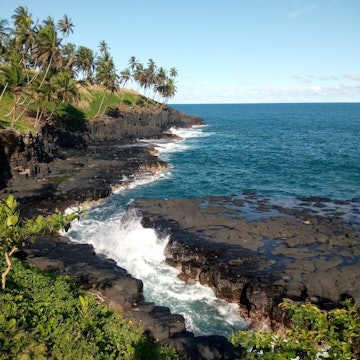
How to see the animals from 'The Lion King' for real in Africa
Jul 3, 2019 • 6 min read

A lioness getting a view over the plains from one of the many large boulders in the Serengeti National Park. roevin / Getty Images
From Banzai, Simba and Shenzi to Pumbaa, Timon and Zazu, the characters of The Lion King have captivated millions, both young and old, since the original animated feature was released 25 years ago. With the live-action remake out on 19 July, we thought we’d reintroduce you to some of the species featured in this famous film and provide some advice on the best places to see them in the wilds of Africa.
Lions
Simba (named after the Swahili word for lion) and his extended family of Scar, Mufasa, Nala, Sarabi and Sarafina portray traits often seen in Africa’s biggest cats when in the wild – loving and loyal, lions can also be fierce, lazy and occasionally loathsome. Unsurprisingly, this fascinating and powerful species is one of the most sought after by safari goers.
The shared ecosystem of Kenya’s Masai Mara and Tanzania’s Serengeti is perhaps the most iconic of settings to observe lions living life as they have done for time immemorial. The vast rolling savannahs punctuated with flat-topped acacia trees is the quintessential safari setting in East Africa. And the Serengeti’s large, horizon-busting outcrops seem straight from the movie reel.
Other incredible locations to follow lions in live action include Chobe National Park and the Okavango Delta in Botswana, Kruger National Park in South Africa and South Luangwa National Park in Zambia. The latter is famous for its guided walking safaris that put you on level footing with lions in their natural habitat.

Warthogs
Who can forget Pumbaa, with his lofty tail and large curved tusks? Once considered one of the ‘Ugly Five’ in the safari world, the warthog’s reputation has been forever transformed by this humorous character in The Lion King. His name aptly translates to ‘silly or foolish’ in Swahili.
Their tails shooting skyward as they scamper off when spooked now never fails to garner smiles from those on safari. It’s believed this behaviour facilitates them to follow each other when dashing into deep grass for cover. Many guides affectionately call their tails ‘bush antennas’. Also endearing is the warthog’s eating stance – with long legs and short necks, it has evolved pads on its front knees to allow them to kneel down while grazing. The species name relates not to actual warts, but rather large growths of fat and skin on their faces that provide some protection during mating season fights.
Warthogs are widely distributed across Southern, West and East Africa. Eastern South Africa, northern Namibia, northern Botswana, Zimbabwe, Zambia, Mozambique, Tanzania, Uganda and southern Kenya are all hot spots.

Meerkats
And where there is Pumbaa, there is of course Timon. This meerkat character is one of the few in The Lion King whose name does not have a meaning in Swahili – though it is derived from a Greek word that means ‘to honour or respect’.
In the wild meerkats live in large family groups of up to 50 members and reside within complex networks of underground tunnels in desert regions of Botswana, Namibia and South Africa. Omnivorous, it eats everything from plants, insects and eggs to snakes, lizards and scorpions. Remarkably, dining on the latter is possible due to the species having an immunity to scorpions’ poison. While members of the family dig and forage for food, others act as sentries to keep an eye out for predators, both on the horizon and in the sky above.
One of the most rewarding experiences is to visit the groups of habituated meerkats within Ntwetwe Pan in the Makgadikgadi and Nxai Pan region of Botswana. While still wild, these meerkats have no fear of humans, which means the sentries may actually clamber right up your leg and up to the top of your head. Rather than looking for affection, they are just using you to get a more expansive view of possible predators on the prowl. Simply stand still and they will eventually move on.
Spotted hyenas
Did you know Scar’s three spotted hyena henchmen – Shenzi, Banzai and Ed – were originally supposed to be African wild dogs? It’s thought that this was changed given the ferocious rivalry between lions and spotted hyena on the East African plains, and the fact that the distribution of endangered wild dogs is more centred on Southern Africa.
Spotted hyenas are fascinating creatures, with the females outweighing the males and playing a more dominant role in their large clans. Wrongly labelled mere scavengers, these hyenas are incredibly skilled hunters and are known to take down wildebeest, zebra, antelope and even juvenile hippos. It’s actually not uncommon for lions to scavenge from hyena kills. With some of the strongest jaws in the animal kingdom, these creatures will even eat the bones of their prey – as a result their droppings are often white in colour.
There are more than 7000 spotted hyena in Serengeti National Park alone, which make it and the adjacent Masai Mara prime territories to see them. Though as the spotted hyena is primarily nocturnal, you’ll likely need to be up at the crack of dawn to catch a glimpse. As the three main waterholes at Namibia’s Etosha National Park are floodlit and open to visitors throughout the night, it is a fantastic place to observe the captivating dynamics of hyena clans at work.
Far from the wilds, but mesmerising just the same, are the spotted hyenas that visit the ancient walled town of Harar in Ethiopia each evening. Just outside the city gates it’s possible to observe them being fed by the ‘hyena men’, some of whom hold the meat from their very mouths.

Mandrills
The character Rafiki, whose name means ‘friend’ in Swahili, is a mandrill. The largest of all monkeys, the mandrill looks much like it has come off the worse after a run-in with a graffiti artist. Its brilliantly coloured face and rump almost need to be seen to be believed.
Reclusive and shy, this species distribution is limited to the equatorial rainforests of central Africa. The best bet of seeing one in the wild is within Lopé National Park in Gabon.

Red-billed hornbills
Last but not least is Zazu, the red-billed hornbill. Known for its swooping flight pattern and long curved bill, this bird has a unique nesting ritual. The female will lay up to half a dozen eggs in a tree hole before imprisoning herself inside for the duration of the incubation by sealing the entrance with a mixture of mud, fruit pulp and droppings – only a small hole is left for the male to transfer food inside to the mother.
There are up to five different species of red-billed hornbill and they combine to cover most of the woodlands and savannah of sub-Saharan Africa. You’d be unlucky not to see one on safari wherever you travel.















